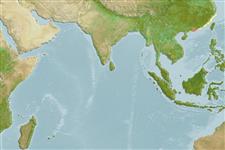Bivalvia |
Galeommatida |
Galeommatidae
Environment: milieu / climate zone / depth range / distribution range
Ecology
Benthic; depth range ? - 12 m (Ref. 75840). Subtropical
Northwest Pacific: China and Hong Kong.
Length at first maturity / Size / Weight / Age
Maturity: Lm ? range ? - ? cm
Subtidal to a depth of 12 meters, on coral galleries (Ref. 75840). Reported from Hong Kong to be found on the ceilings and walls of submarine caves (Ref. 126058).
Life cycle and mating behavior
Maturity | Reproduction | Spawning | Eggs | Fecundity | Larvae
Members of the class Bivalvia are mostly gonochoric, some are protandric hermaphrodites. Life cycle: Embryos develop into free-swimming trocophore larvae, succeeded by the bivalve veliger, resembling a miniature clam.
Morton, B. 1976 Secondary brooding of temporary dwarf males in Ephippodonta (Ephippodontina) oedipus sp.n. (Bivalvia:Leptonacea). Journal of Conchology, London 29:31-39. (Ref. 77677)
IUCN Red List Status
(Ref. 130435: Version 2025-1)
CITES status (Ref. 108899)
Not Evaluated
Not Evaluated
Threat to humans
Human uses
| FishSource |
Tools
More information
Trophic EcologyFood items (preys)
Diet composition
Food consumption
Predators
Population dynamicsGrowth
Max. ages / sizes
Length-weight rel.
Length-length rel.
Length-frequencies
Mass conversion
Abundance
Life cycleReproductionMaturityFecunditySpawningEggsEgg developmentLarvae PhysiologyOxygen consumption
Human RelatedStamps, coins, misc.
Internet sources
Estimates based on models
